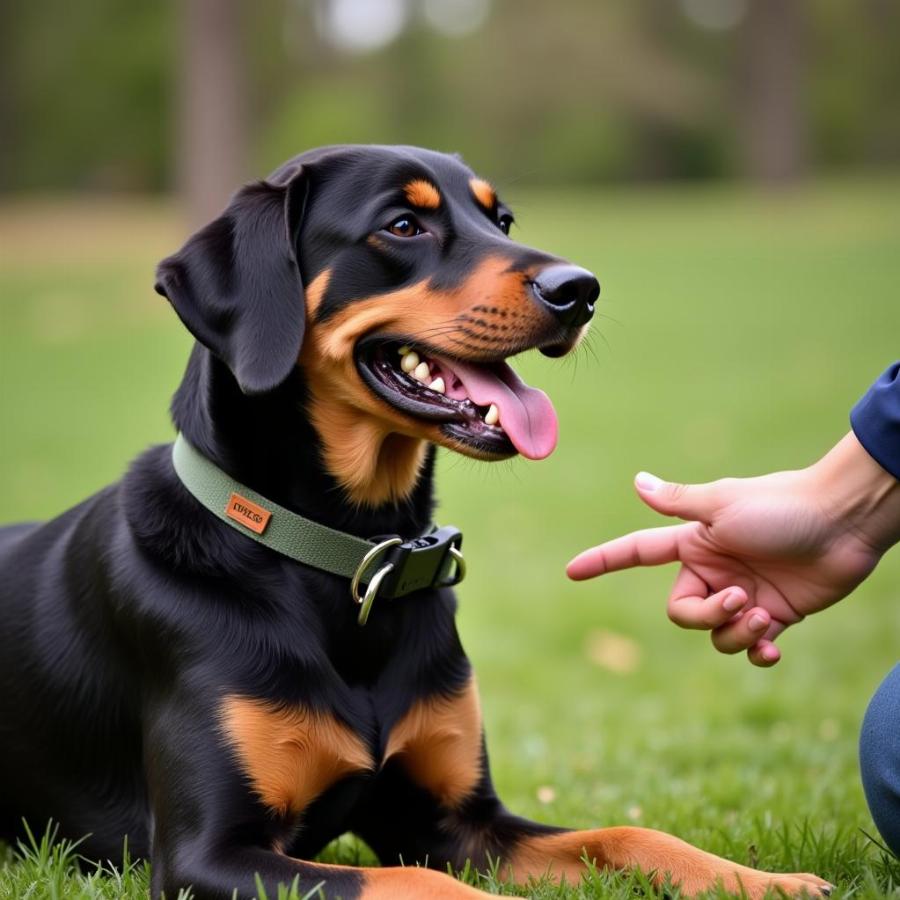Prong collars, also known as pinch collars, are a type of dog training collar that have metal prongs designed to tighten around a dog’s neck when pulled. While often marketed as a quick-fix solution for leash pulling, the use of prong collars remains a hotly debated topic within the dog training community. This article delves into the mechanics, uses, potential risks, and humane alternatives to prong collars, providing dog owners with the information they need to make informed decisions about their dog’s training.
How Prong Collars Work and Their Intended Use
Prong collars work by distributing pressure around a dog’s neck when the leash is pulled. The prongs, located on the inside of the collar, create a pinching sensation on the dog’s skin, which is intended to deter pulling. Proponents of prong collars often argue that this type of pressure is similar to the correction a mother dog would give to her puppies.
The Controversy Surrounding Prong Collars
Despite their purported effectiveness, prong collars are widely criticized for their potential to cause pain, discomfort, and even injury to dogs. The pinching sensation from the prongs can be aversive and stressful, leading to negative associations with training and walks.
Potential Risks and Ethical Concerns
The use of prong collars raises significant welfare concerns. Here are some potential risks:
- Physical Injury: Improper use or fitting can lead to skin punctures, bruising, and damage to the trachea or esophagus.
- Pain and Discomfort: The pinching sensation, even when used correctly, can cause pain and distress, especially for dogs with sensitive skin or pre-existing medical conditions.
- Behavioral Issues: Prong collars can exacerbate aggression, fear, and anxiety in some dogs. The use of aversive tools can create a negative feedback loop, leading to further behavioral problems.
 Dog Training with Positive Reinforcement
Dog Training with Positive Reinforcement
Humane and Effective Alternatives to Prong Collars
Fortunately, there are numerous humane and effective alternatives to prong collars that prioritize a dog’s physical and emotional well-being:
1. Harness Training:
Harnesses provide a more comfortable and humane way to manage pulling by distributing pressure evenly across a dog’s chest and shoulders, reducing strain on the neck.
2. Positive Reinforcement Techniques:
Reward-based training methods, using treats, praise, and toys, are highly effective in teaching dogs desirable leash manners without resorting to pain or discomfort.
3. Seek Professional Guidance:
Consulting with a certified dog trainer or behaviorist can provide personalized training plans tailored to your dog’s specific needs and address any underlying behavioral issues contributing to pulling.
Making Informed Choices for Your Dog
“Choosing the right training tools for your dog should always prioritize their well-being,” says renowned canine behaviorist, Dr. Emily Carter. “Focusing on positive reinforcement and understanding your dog’s individual needs are crucial elements of ethical and effective training.”
Conclusion
While prong collars might seem like a quick fix for leash pulling, it’s essential to weigh their potential risks against their purported benefits. Prioritizing your dog’s physical and emotional well-being should always be paramount. Humane alternatives, like harness training and positive reinforcement techniques, offer effective and compassionate solutions for teaching dogs to walk politely on a leash. Remember, a well-trained dog is a happy dog!
FAQs about Prong Collars
Are prong collars ever recommended by veterinarians?
While some veterinarians may suggest prong collars in specific situations, many advocate against their use due to potential health risks and the availability of safer alternatives.
Can prong collars be used on puppies?
Prong collars should never be used on puppies or dogs with delicate necks as they can cause serious injury.
Are there any dog breeds that should never wear prong collars?
Brachycephalic breeds (dogs with short noses and flat faces) and dogs with respiratory issues should never wear prong collars due to the increased risk of breathing difficulties.
What should I do if my dog reacts negatively to a prong collar?
Immediately cease using the collar and consult with a certified dog trainer or veterinarian to explore alternative training methods.
Are there any laws against using prong collars?
Laws regarding prong collars vary depending on your location. It’s essential to research and understand the regulations in your area.
Looking for More Helpful Tips?
- Learn more about dog correction collar
- Explore other positive training methods on Beaut Dogs.
Beaut Dogs is your one-stop resource for reliable, helpful, and in-depth information about the wonderful world of dogs. From understanding different breeds to expert advice on care and training, we’re here to help you provide the best possible life for your furry friend. For any questions or concerns, feel free to reach out to us at [email protected]. Let Beaut Dogs be your guide to responsible dog ownership.